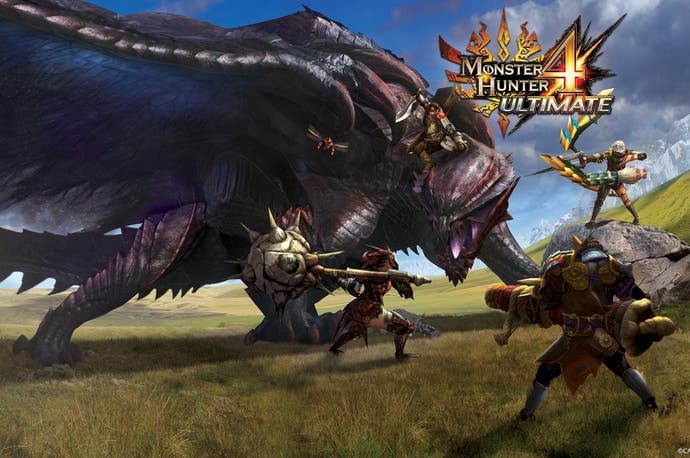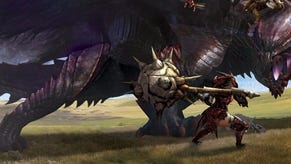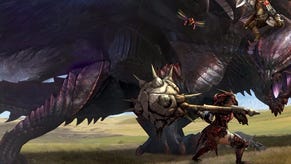Pick-ups and play: How Monster Hunter gets loot right
How the west was wrong.
Loot is the new level up. A few years ago, people posted about their fourth prestige on Facebook, most probably humming Call of Duty's butt-rock progression jingle as they did so. Come 2015, and my Twitter feed is cut with great swathes of pictures of Destiny's tooled-up future-warriors, owners boasting about their new exotic codpiece, screenshots saturated by more purple than a Prince album cover.
When Borderlands became a hit, haughty nerds like me positively vibrated with surprise that a loot game could capture public imagination. Men and women weaned on Diablo's click 'n' collect appeal suddenly saw the thrill of an unexpected stat buff transformed into the lure of Gearbox's (admittedly shaky) bazillion gun promise.
Bungie's troubled masterpiece is the last link in that chain - the proof is in the pudding, and you can be sure that Activision are dining out on their 16 million-player dessert. It's a game steeped as much in swirling sets of metagame calculations as it is the Halo nostalgia that powers its combat. When an RPG, halfway through, starts making loot the only way to level up, you know something's changed.
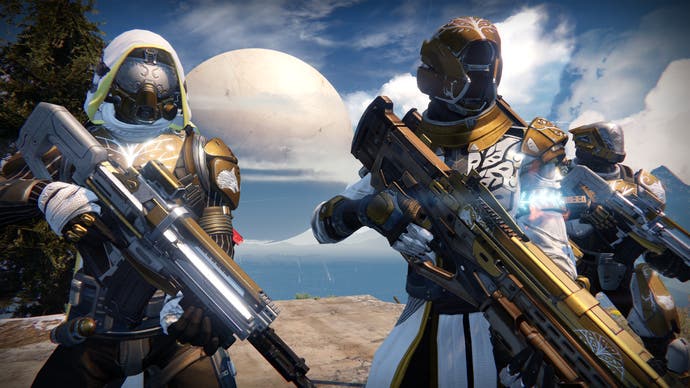
There's a case to be made that this is among gaming's most insidious trends. The line-graph of levelling up - fair pay for a good day's play - has been replaced with what amounts to gambling, your time used as the chips. Loot games are predicated on chance - the feeling of achievement at finding the perfect rocket launcher is far greater than a number going up by one, not least because, often, it'll be the only way you can meaningfully progress through the game. But there's the nagging possibility that it won't come for hours of practically unrewarded busywork.
Of course, if you're happy to put in the time, this is no real issue - particularly when it's put into a game that can feel as good simply to play as Destiny - but it opens some troubling doors for less scrupulous designers. Take Dragon Age: Inquisition's multiplayer. The majority of its characters are locked behind incredibly rare drops, but spend a little real money and you can buy loot booster packs. It's a mere probability increase, you're never promised a rare reward, and what was a time-bet suddenly becomes a higher-stakes affair.
All of which is to say that loot can be done so much better. Well, it has been done better, it's just that the west, players and developers alike, have yet to fully realise ('realise' in this case being used to mean 'creating a land-conquering commercial success').

Monster Hunter is a series that not only gets loot right, but makes its acquisition the beating heart of the entire game, and never more so than in its latest iteration. Like its predecessors, there are no levels in Monster Hunter 4 Ultimate, no steady climb in stats to go alongside your constant process of acquisition. Weapon and armour abilities are all you have to rely on as a player, meaning making newer, better items is your only means of progression. Alongside that comes the realisation that loot drops are as much a puzzle as they are a reward.
If your new bowgun needs spider mandibles to make, you head to the nearest mega-spider nest and smash its skittering resident in the face with a hammer until one of those mandibles can be more easily sawn off. It's that reactive loot, rewarding your thinking with the correct drops, that makes the feeling of achievement so much more tangible. This isn't to say there isn't an element of chance at work - plants, berries and ores are semi-randomised with every visit to an area, and the rarest items carved from monsters are either sparse or simply impossible to obtain without working out which piece of the beast to concentrate your attacks on.
The difference here is that you're not waiting for the electric bear-lizard you've been pummelling to fall over and spill a much-needed lance from its guts - barring some very rare examples, you'll be building every item you want from scratch, scrabbling together multiple elements to make the piece you want. Chance here is part of a wider scheme, not the be-all and end-all of success. It means that a full, five-piece armour set, particularly, is a document of the time you spent building it - and that time can be spent in so many different ways.
My Seltas armour is the product of hours of the same fight, a mammoth beetle queen and a single, hard-to-get extract of her saliva standing between me and some fancy green moonboots. Except, truthfully, it wasn't the same fight every time - it increasingly became a dance, as I was forced to understand her dizzying number of attack animations, predicting how she'd move and how I could most efficiently jab my sword through her tiny mouth for the precious shoe-juice I required. This is nature's great challenge inflated into fantasy - you can't build a house until you know how to cut down a tree; you can't make cool, emerald armour until you've learned everything about the insectoid beast you're chopping it off of.
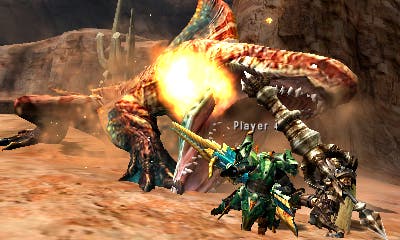
Compare that to my hard-won Lobster mail, complete with grotesquely black-eyed, dinner-ready cosplay helmet. This popped up unexpectedly in my Forge list after I fished a crustacean out of the sea in one of the game's few minigames. What followed was days of searching for obscure ingredients, requiring me to hunt two separate monsters, cultivate bugs, mine for ore and travel through numerous areas. It's as much a suit of armour as it is a map of the game's tentacular, interlocking systems.
Monster Hunter 4 does a great job of introducing a narrative thrust to a series that's always struggled to tell a story, but its greatest work is in turning its gaudy, ludicrous costumes and weaponry into stories themselves. To nab an idea from Eurogamer's own Mr. Donlan, every item you earn involves a single ritual:
- Deciding what you want to build.
- Working out how to do so.
- Amassing and equipping the items you need to survive going out to do so.
- Collecting the myriad loot you need to do so.
- Doing so.
Often, you'll realise halfway through this process (hopefully at the third point, but usually at the fourth) that you simply can't handle your next target, at which point you start a new, nested ritual to build the armour or weapon you need to continue with the first.
Your quest for loot leads to weaving, player-set quests that take you back and forth through the game, waves of necessity lapping you up and down ranked challenges you'd otherwise assume had been put in a specific order. What starts as a singular process yields dizzyingly varied results - like cooking, the same set of ingredients can make any number of different dishes.
Destiny and its ilk works off of the warm feeling of being done a favour - firing high-calibre rounds into a boss until the Great Algorithm In The Sky deigns you deserving of a new hat. Monster Hunter forces you to earn even the smallest upgrade, and the satisfaction is so much greater for the effort. You're not betting your time here, you're investing it.
With thanks to Sean Bell, for both his advice and unparalleled ability to pull off sleep arrow-barrel bomb combos.
